Control Weeds Assessment Guide Questions: AHCPMG301
VerifiedAdded on 2023/04/21
|34
|8767
|361
Homework Assignment
AI Summary
This document presents the answers to a series of questions from the AHCPMG301 Control Weeds Assessment Guide. The assessment covers various aspects of weed management, including the identification of weed characteristics, methods of weed spread, and relevant government regulations. It explores different weed control strategies, such as cultural, mechanical, biological, preventative, and chemical methods, providing examples for each. The assessment also delves into Integrated Pest Management (IPM) strategies, including the use of biological agents like predators, antagonists, and pathogens. Furthermore, it addresses the avoidance of herbicide resistance and methods for monitoring biological beneficials within an IPM strategy. The guide emphasizes workplace health and safety, environmental considerations, and the importance of staying updated with new developments in weed control technology and regulations.
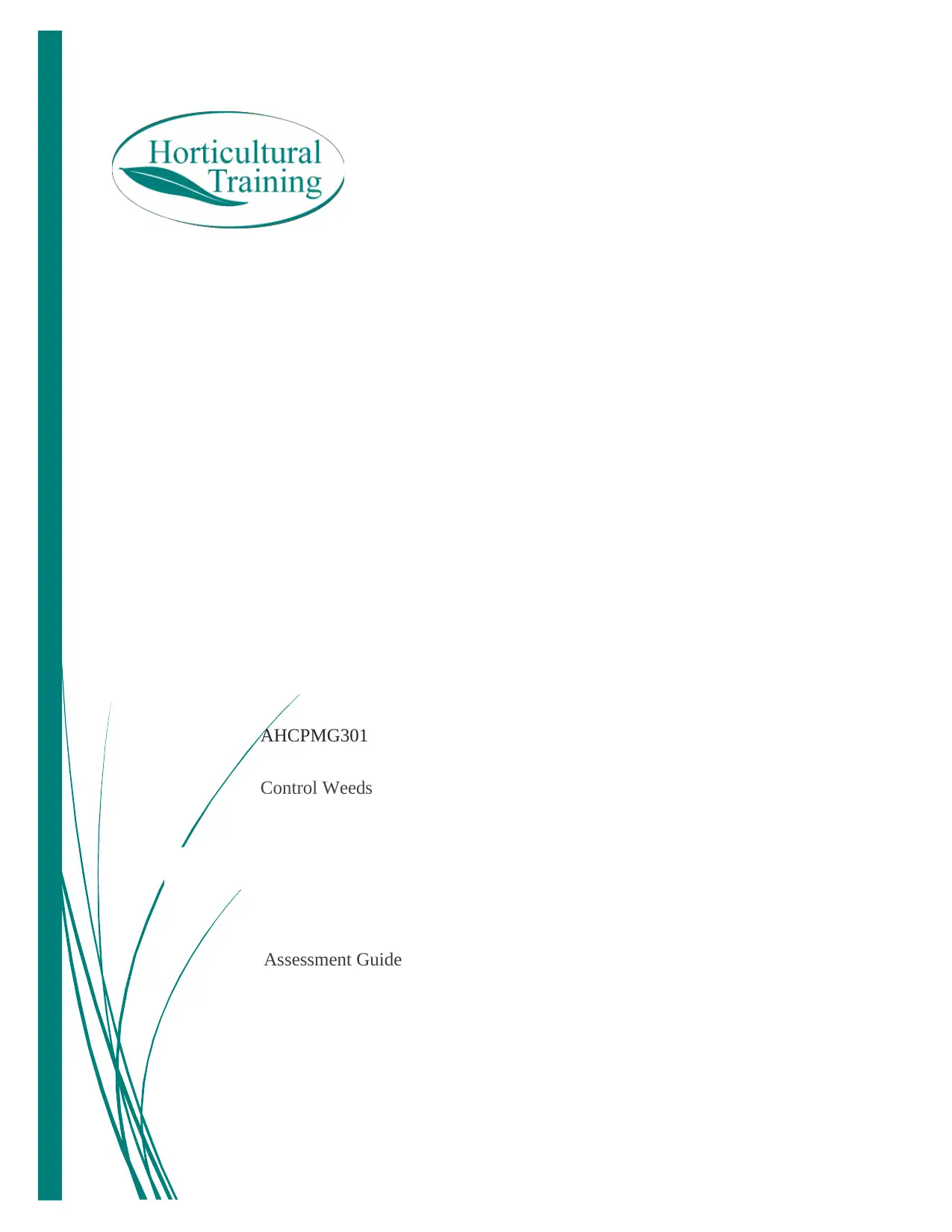
AHCPMG301
Control Weeds
Assessment Guide
Control Weeds
Assessment Guide
Paraphrase This Document
Need a fresh take? Get an instant paraphrase of this document with our AI Paraphraser
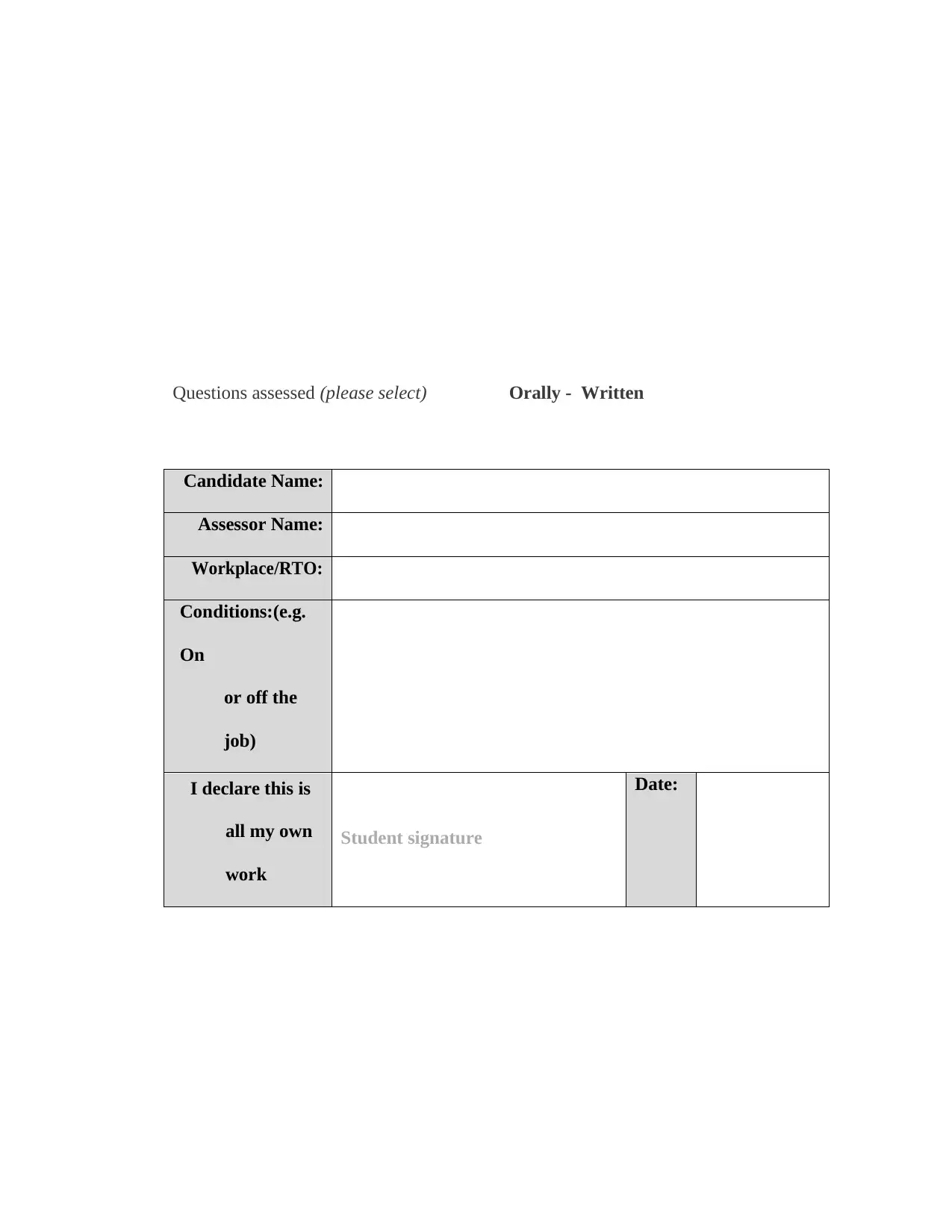
Questions assessed (please select) Orally - Written
Candidate Name:
Assessor Name:
Workplace/RTO:
Conditions:(e.g.
On
or off the
job)
I declare this is
all my own
work
Student signature
Date:
Candidate Name:
Assessor Name:
Workplace/RTO:
Conditions:(e.g.
On
or off the
job)
I declare this is
all my own
work
Student signature
Date:
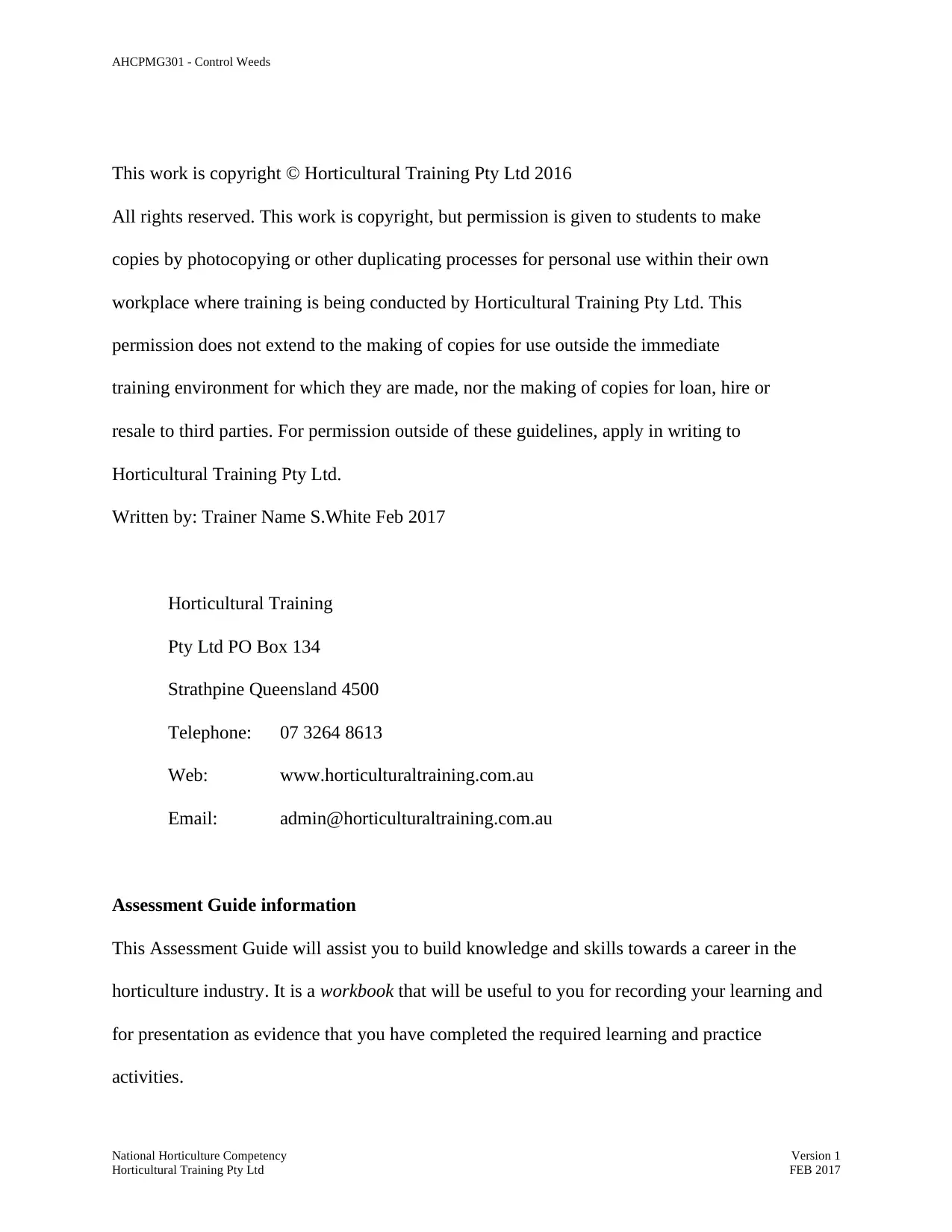
AHCPMG301 - Control Weeds
National Horticulture Competency
Horticultural Training Pty Ltd
Version 1
FEB 2017
This work is copyright © Horticultural Training Pty Ltd 2016
All rights reserved. This work is copyright, but permission is given to students to make
copies by photocopying or other duplicating processes for personal use within their own
workplace where training is being conducted by Horticultural Training Pty Ltd. This
permission does not extend to the making of copies for use outside the immediate
training environment for which they are made, nor the making of copies for loan, hire or
resale to third parties. For permission outside of these guidelines, apply in writing to
Horticultural Training Pty Ltd.
Written by: Trainer Name S.White Feb 2017
Horticultural Training
Pty Ltd PO Box 134
Strathpine Queensland 4500
Telephone: 07 3264 8613
Web: www.horticulturaltraining.com.au
Email: admin@horticulturaltraining.com.au
Assessment Guide information
This Assessment Guide will assist you to build knowledge and skills towards a career in the
horticulture industry. It is a workbook that will be useful to you for recording your learning and
for presentation as evidence that you have completed the required learning and practice
activities.
National Horticulture Competency
Horticultural Training Pty Ltd
Version 1
FEB 2017
This work is copyright © Horticultural Training Pty Ltd 2016
All rights reserved. This work is copyright, but permission is given to students to make
copies by photocopying or other duplicating processes for personal use within their own
workplace where training is being conducted by Horticultural Training Pty Ltd. This
permission does not extend to the making of copies for use outside the immediate
training environment for which they are made, nor the making of copies for loan, hire or
resale to third parties. For permission outside of these guidelines, apply in writing to
Horticultural Training Pty Ltd.
Written by: Trainer Name S.White Feb 2017
Horticultural Training
Pty Ltd PO Box 134
Strathpine Queensland 4500
Telephone: 07 3264 8613
Web: www.horticulturaltraining.com.au
Email: admin@horticulturaltraining.com.au
Assessment Guide information
This Assessment Guide will assist you to build knowledge and skills towards a career in the
horticulture industry. It is a workbook that will be useful to you for recording your learning and
for presentation as evidence that you have completed the required learning and practice
activities.
⊘ This is a preview!⊘
Do you want full access?
Subscribe today to unlock all pages.

Trusted by 1+ million students worldwide
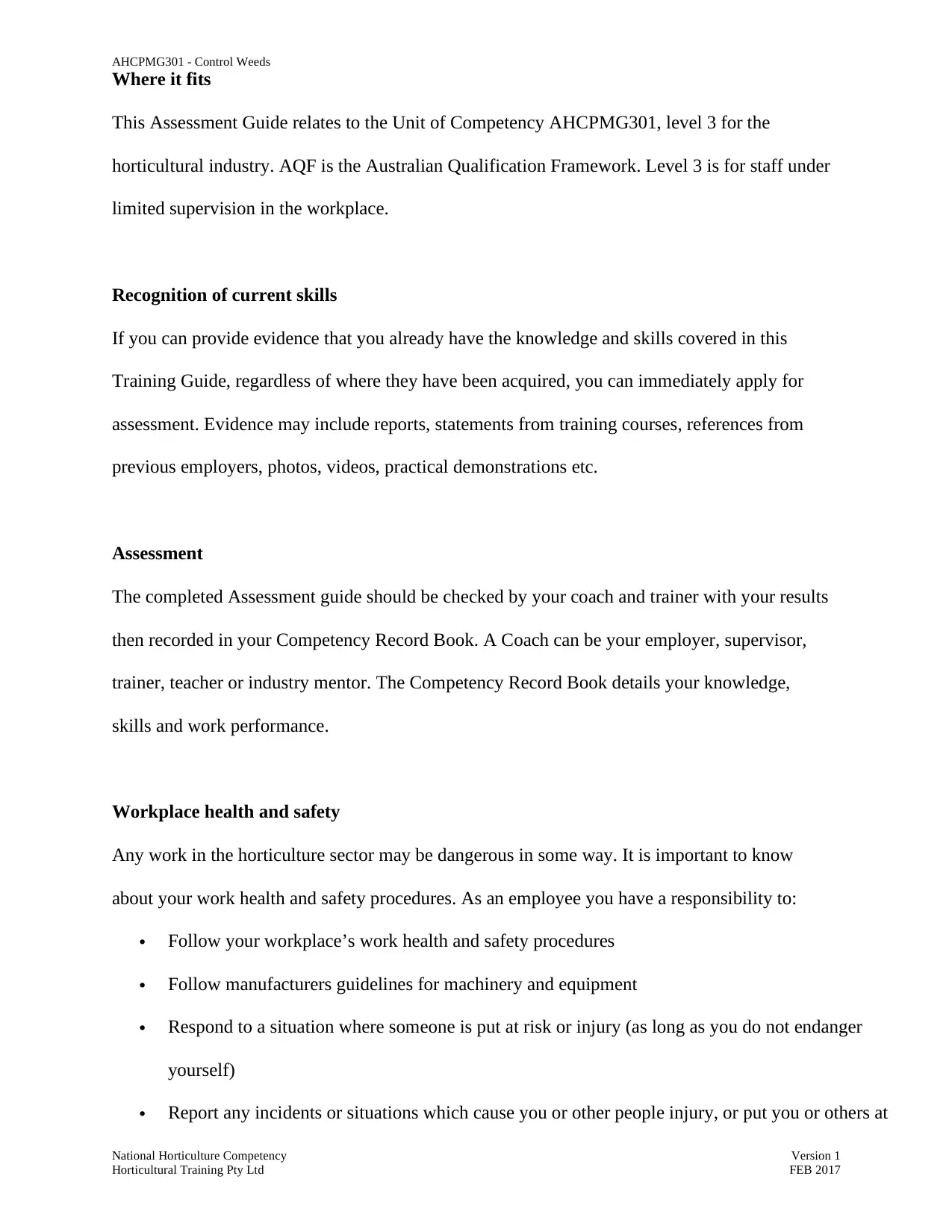
AHCPMG301 - Control Weeds
National Horticulture Competency
Horticultural Training Pty Ltd
Version 1
FEB 2017
Where it fits
This Assessment Guide relates to the Unit of Competency AHCPMG301, level 3 for the
horticultural industry. AQF is the Australian Qualification Framework. Level 3 is for staff under
limited supervision in the workplace.
Recognition of current skills
If you can provide evidence that you already have the knowledge and skills covered in this
Training Guide, regardless of where they have been acquired, you can immediately apply for
assessment. Evidence may include reports, statements from training courses, references from
previous employers, photos, videos, practical demonstrations etc.
Assessment
The completed Assessment guide should be checked by your coach and trainer with your results
then recorded in your Competency Record Book. A Coach can be your employer, supervisor,
trainer, teacher or industry mentor. The Competency Record Book details your knowledge,
skills and work performance.
Workplace health and safety
Any work in the horticulture sector may be dangerous in some way. It is important to know
about your work health and safety procedures. As an employee you have a responsibility to:
Follow your workplace’s work health and safety procedures
Follow manufacturers guidelines for machinery and equipment
Respond to a situation where someone is put at risk or injury (as long as you do not endanger
yourself)
Report any incidents or situations which cause you or other people injury, or put you or others at
National Horticulture Competency
Horticultural Training Pty Ltd
Version 1
FEB 2017
Where it fits
This Assessment Guide relates to the Unit of Competency AHCPMG301, level 3 for the
horticultural industry. AQF is the Australian Qualification Framework. Level 3 is for staff under
limited supervision in the workplace.
Recognition of current skills
If you can provide evidence that you already have the knowledge and skills covered in this
Training Guide, regardless of where they have been acquired, you can immediately apply for
assessment. Evidence may include reports, statements from training courses, references from
previous employers, photos, videos, practical demonstrations etc.
Assessment
The completed Assessment guide should be checked by your coach and trainer with your results
then recorded in your Competency Record Book. A Coach can be your employer, supervisor,
trainer, teacher or industry mentor. The Competency Record Book details your knowledge,
skills and work performance.
Workplace health and safety
Any work in the horticulture sector may be dangerous in some way. It is important to know
about your work health and safety procedures. As an employee you have a responsibility to:
Follow your workplace’s work health and safety procedures
Follow manufacturers guidelines for machinery and equipment
Respond to a situation where someone is put at risk or injury (as long as you do not endanger
yourself)
Report any incidents or situations which cause you or other people injury, or put you or others at
Paraphrase This Document
Need a fresh take? Get an instant paraphrase of this document with our AI Paraphraser
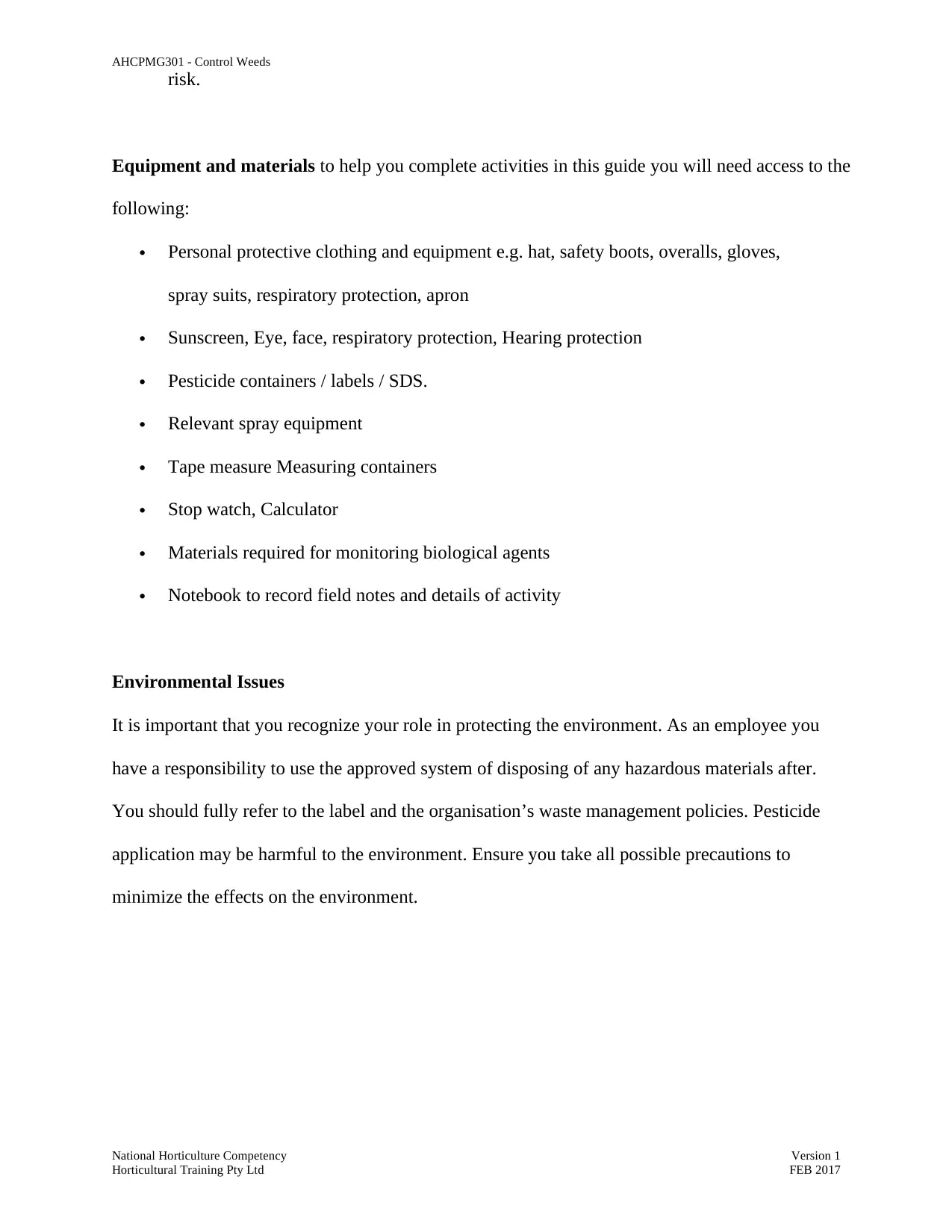
AHCPMG301 - Control Weeds
National Horticulture Competency
Horticultural Training Pty Ltd
Version 1
FEB 2017
risk.
Equipment and materials to help you complete activities in this guide you will need access to the
following:
Personal protective clothing and equipment e.g. hat, safety boots, overalls, gloves,
spray suits, respiratory protection, apron
Sunscreen, Eye, face, respiratory protection, Hearing protection
Pesticide containers / labels / SDS.
Relevant spray equipment
Tape measure Measuring containers
Stop watch, Calculator
Materials required for monitoring biological agents
Notebook to record field notes and details of activity
Environmental Issues
It is important that you recognize your role in protecting the environment. As an employee you
have a responsibility to use the approved system of disposing of any hazardous materials after.
You should fully refer to the label and the organisation’s waste management policies. Pesticide
application may be harmful to the environment. Ensure you take all possible precautions to
minimize the effects on the environment.
National Horticulture Competency
Horticultural Training Pty Ltd
Version 1
FEB 2017
risk.
Equipment and materials to help you complete activities in this guide you will need access to the
following:
Personal protective clothing and equipment e.g. hat, safety boots, overalls, gloves,
spray suits, respiratory protection, apron
Sunscreen, Eye, face, respiratory protection, Hearing protection
Pesticide containers / labels / SDS.
Relevant spray equipment
Tape measure Measuring containers
Stop watch, Calculator
Materials required for monitoring biological agents
Notebook to record field notes and details of activity
Environmental Issues
It is important that you recognize your role in protecting the environment. As an employee you
have a responsibility to use the approved system of disposing of any hazardous materials after.
You should fully refer to the label and the organisation’s waste management policies. Pesticide
application may be harmful to the environment. Ensure you take all possible precautions to
minimize the effects on the environment.
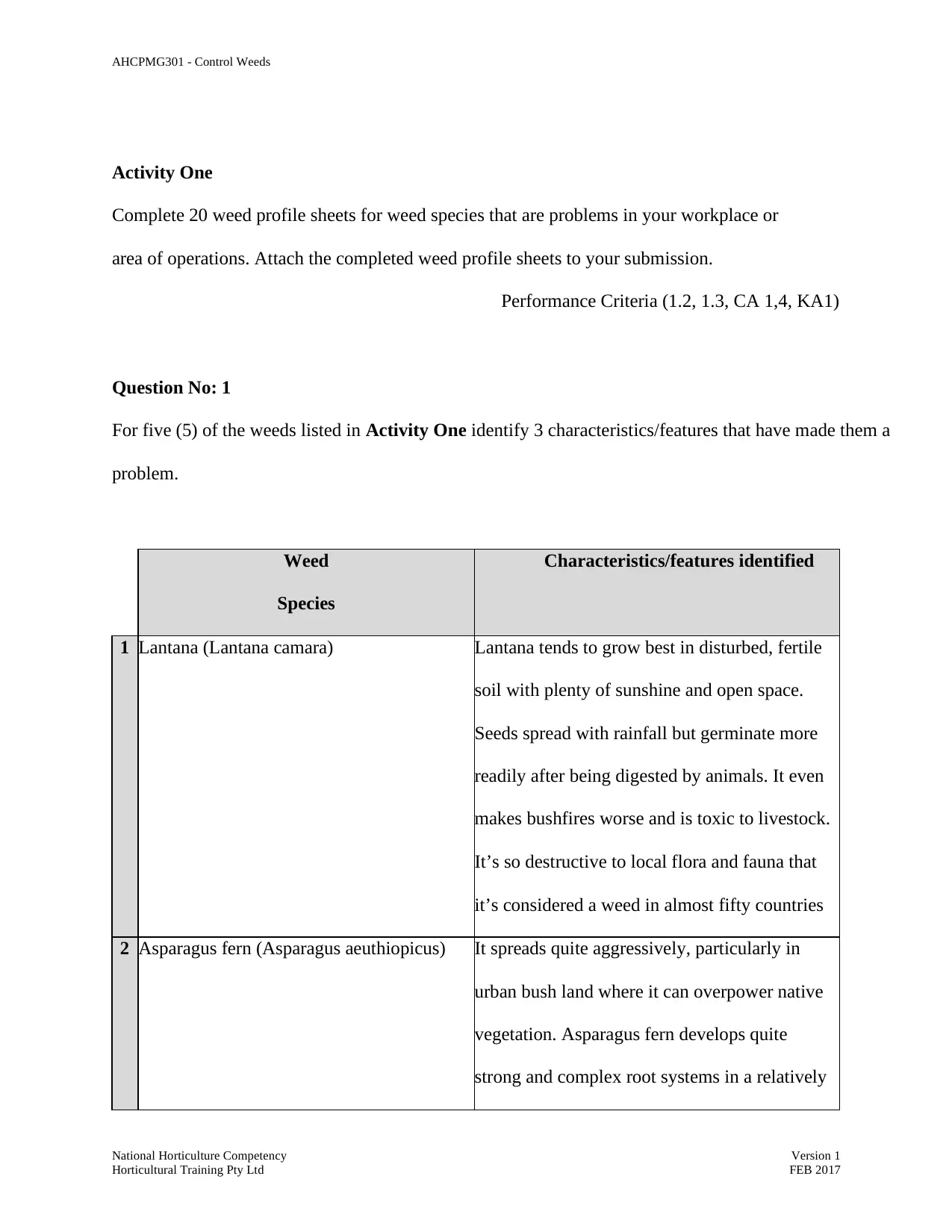
AHCPMG301 - Control Weeds
National Horticulture Competency
Horticultural Training Pty Ltd
Version 1
FEB 2017
Activity One
Complete 20 weed profile sheets for weed species that are problems in your workplace or
area of operations. Attach the completed weed profile sheets to your submission.
Performance Criteria (1.2, 1.3, CA 1,4, KA1)
Question No: 1
For five (5) of the weeds listed in Activity One identify 3 characteristics/features that have made them a
problem.
Weed
Species
Characteristics/features identified
1 Lantana (Lantana camara) Lantana tends to grow best in disturbed, fertile
soil with plenty of sunshine and open space.
Seeds spread with rainfall but germinate more
readily after being digested by animals. It even
makes bushfires worse and is toxic to livestock.
It’s so destructive to local flora and fauna that
it’s considered a weed in almost fifty countries
2 Asparagus fern (Asparagus aeuthiopicus) It spreads quite aggressively, particularly in
urban bush land where it can overpower native
vegetation. Asparagus fern develops quite
strong and complex root systems in a relatively
National Horticulture Competency
Horticultural Training Pty Ltd
Version 1
FEB 2017
Activity One
Complete 20 weed profile sheets for weed species that are problems in your workplace or
area of operations. Attach the completed weed profile sheets to your submission.
Performance Criteria (1.2, 1.3, CA 1,4, KA1)
Question No: 1
For five (5) of the weeds listed in Activity One identify 3 characteristics/features that have made them a
problem.
Weed
Species
Characteristics/features identified
1 Lantana (Lantana camara) Lantana tends to grow best in disturbed, fertile
soil with plenty of sunshine and open space.
Seeds spread with rainfall but germinate more
readily after being digested by animals. It even
makes bushfires worse and is toxic to livestock.
It’s so destructive to local flora and fauna that
it’s considered a weed in almost fifty countries
2 Asparagus fern (Asparagus aeuthiopicus) It spreads quite aggressively, particularly in
urban bush land where it can overpower native
vegetation. Asparagus fern develops quite
strong and complex root systems in a relatively
⊘ This is a preview!⊘
Do you want full access?
Subscribe today to unlock all pages.

Trusted by 1+ million students worldwide
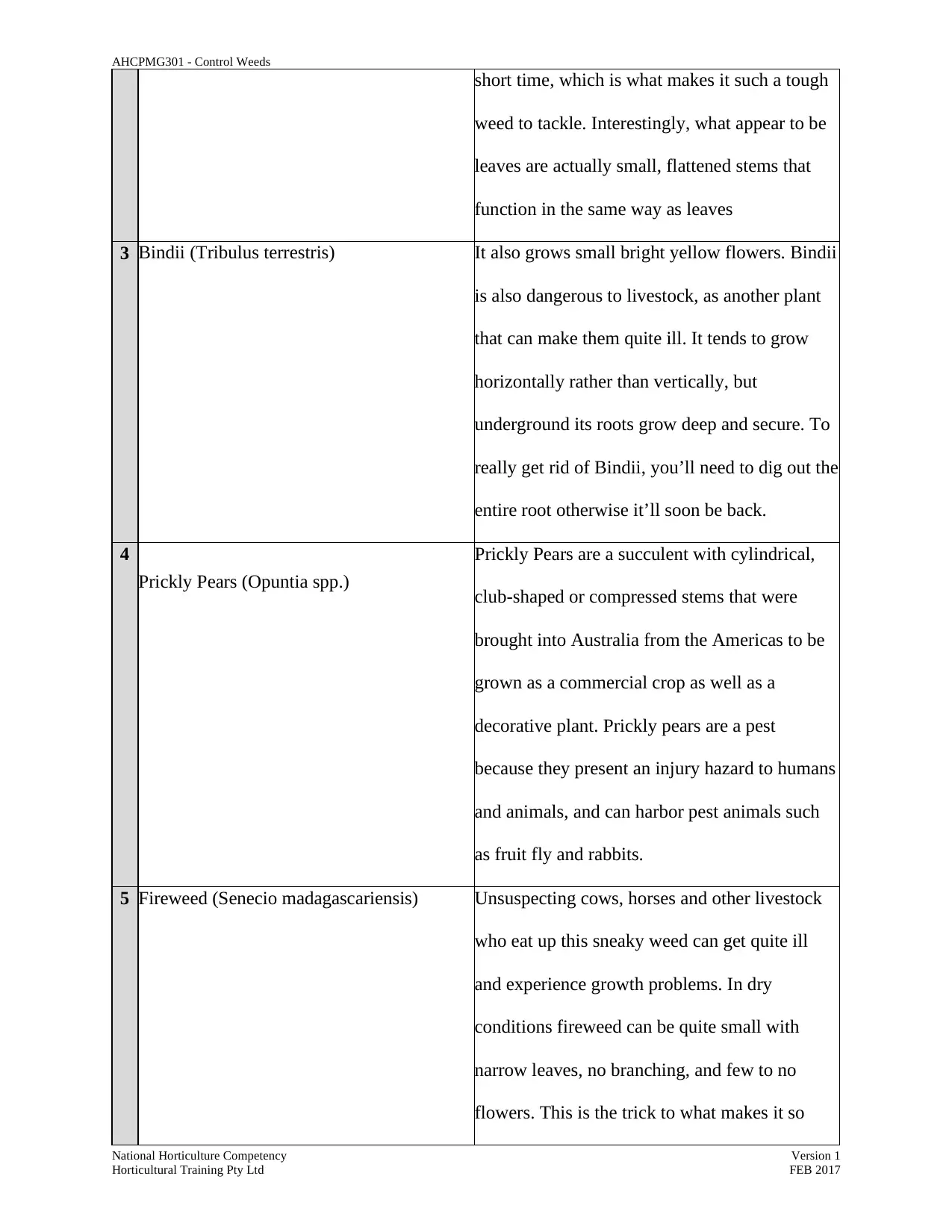
AHCPMG301 - Control Weeds
National Horticulture Competency
Horticultural Training Pty Ltd
Version 1
FEB 2017
short time, which is what makes it such a tough
weed to tackle. Interestingly, what appear to be
leaves are actually small, flattened stems that
function in the same way as leaves
3 Bindii (Tribulus terrestris) It also grows small bright yellow flowers. Bindii
is also dangerous to livestock, as another plant
that can make them quite ill. It tends to grow
horizontally rather than vertically, but
underground its roots grow deep and secure. To
really get rid of Bindii, you’ll need to dig out the
entire root otherwise it’ll soon be back.
4
Prickly Pears (Opuntia spp.)
Prickly Pears are a succulent with cylindrical,
club-shaped or compressed stems that were
brought into Australia from the Americas to be
grown as a commercial crop as well as a
decorative plant. Prickly pears are a pest
because they present an injury hazard to humans
and animals, and can harbor pest animals such
as fruit fly and rabbits.
5 Fireweed (Senecio madagascariensis) Unsuspecting cows, horses and other livestock
who eat up this sneaky weed can get quite ill
and experience growth problems. In dry
conditions fireweed can be quite small with
narrow leaves, no branching, and few to no
flowers. This is the trick to what makes it so
National Horticulture Competency
Horticultural Training Pty Ltd
Version 1
FEB 2017
short time, which is what makes it such a tough
weed to tackle. Interestingly, what appear to be
leaves are actually small, flattened stems that
function in the same way as leaves
3 Bindii (Tribulus terrestris) It also grows small bright yellow flowers. Bindii
is also dangerous to livestock, as another plant
that can make them quite ill. It tends to grow
horizontally rather than vertically, but
underground its roots grow deep and secure. To
really get rid of Bindii, you’ll need to dig out the
entire root otherwise it’ll soon be back.
4
Prickly Pears (Opuntia spp.)
Prickly Pears are a succulent with cylindrical,
club-shaped or compressed stems that were
brought into Australia from the Americas to be
grown as a commercial crop as well as a
decorative plant. Prickly pears are a pest
because they present an injury hazard to humans
and animals, and can harbor pest animals such
as fruit fly and rabbits.
5 Fireweed (Senecio madagascariensis) Unsuspecting cows, horses and other livestock
who eat up this sneaky weed can get quite ill
and experience growth problems. In dry
conditions fireweed can be quite small with
narrow leaves, no branching, and few to no
flowers. This is the trick to what makes it so
Paraphrase This Document
Need a fresh take? Get an instant paraphrase of this document with our AI Paraphraser
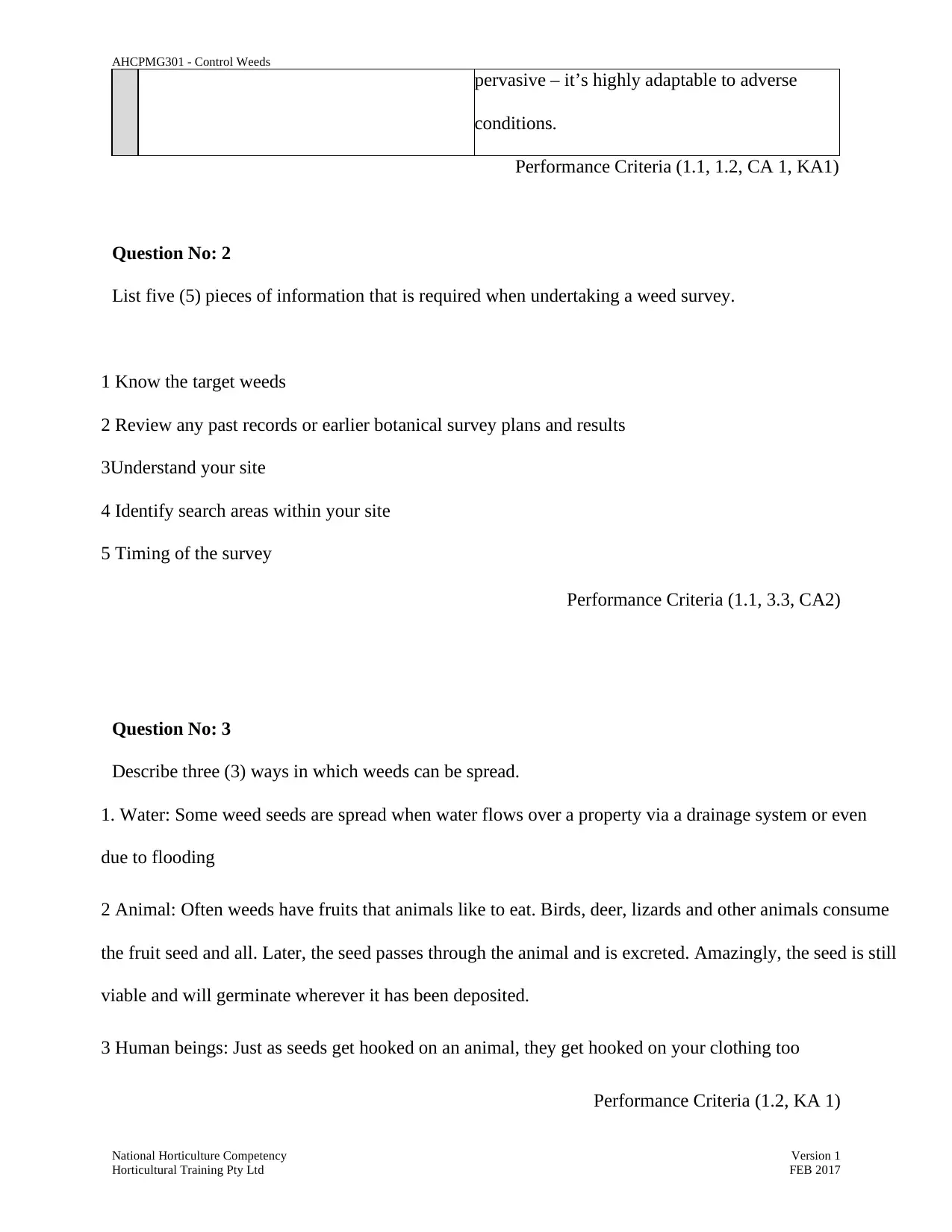
AHCPMG301 - Control Weeds
National Horticulture Competency
Horticultural Training Pty Ltd
Version 1
FEB 2017
pervasive – it’s highly adaptable to adverse
conditions.
Performance Criteria (1.1, 1.2, CA 1, KA1)
Question No: 2
List five (5) pieces of information that is required when undertaking a weed survey.
1 Know the target weeds
2 Review any past records or earlier botanical survey plans and results
3Understand your site
4 Identify search areas within your site
5 Timing of the survey
Performance Criteria (1.1, 3.3, CA2)
Question No: 3
Describe three (3) ways in which weeds can be spread.
1. Water: Some weed seeds are spread when water flows over a property via a drainage system or even
due to flooding
2 Animal: Often weeds have fruits that animals like to eat. Birds, deer, lizards and other animals consume
the fruit seed and all. Later, the seed passes through the animal and is excreted. Amazingly, the seed is still
viable and will germinate wherever it has been deposited.
3 Human beings: Just as seeds get hooked on an animal, they get hooked on your clothing too
Performance Criteria (1.2, KA 1)
National Horticulture Competency
Horticultural Training Pty Ltd
Version 1
FEB 2017
pervasive – it’s highly adaptable to adverse
conditions.
Performance Criteria (1.1, 1.2, CA 1, KA1)
Question No: 2
List five (5) pieces of information that is required when undertaking a weed survey.
1 Know the target weeds
2 Review any past records or earlier botanical survey plans and results
3Understand your site
4 Identify search areas within your site
5 Timing of the survey
Performance Criteria (1.1, 3.3, CA2)
Question No: 3
Describe three (3) ways in which weeds can be spread.
1. Water: Some weed seeds are spread when water flows over a property via a drainage system or even
due to flooding
2 Animal: Often weeds have fruits that animals like to eat. Birds, deer, lizards and other animals consume
the fruit seed and all. Later, the seed passes through the animal and is excreted. Amazingly, the seed is still
viable and will germinate wherever it has been deposited.
3 Human beings: Just as seeds get hooked on an animal, they get hooked on your clothing too
Performance Criteria (1.2, KA 1)
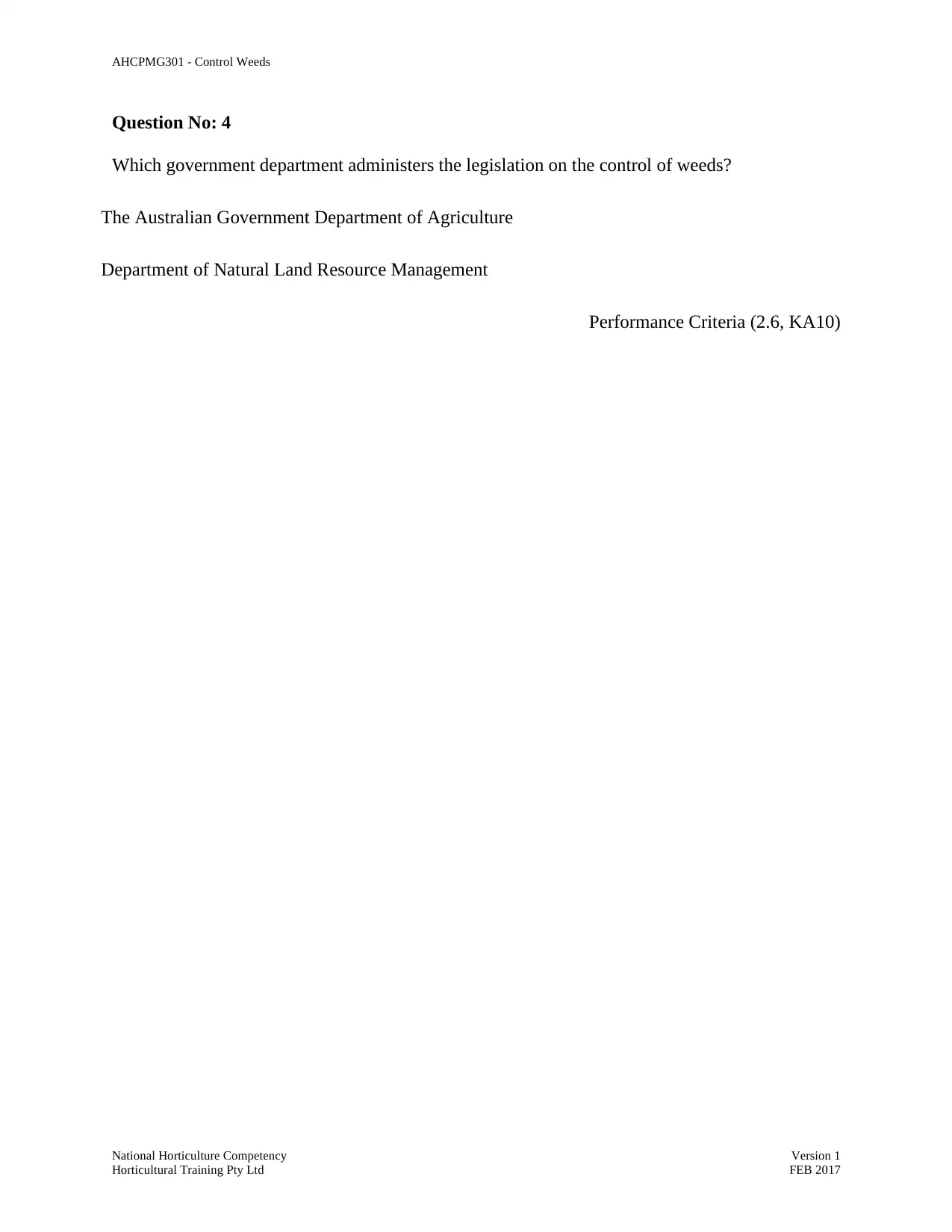
AHCPMG301 - Control Weeds
National Horticulture Competency
Horticultural Training Pty Ltd
Version 1
FEB 2017
Question No: 4
Which government department administers the legislation on the control of weeds?
The Australian Government Department of Agriculture
Department of Natural Land Resource Management
Performance Criteria (2.6, KA10)
National Horticulture Competency
Horticultural Training Pty Ltd
Version 1
FEB 2017
Question No: 4
Which government department administers the legislation on the control of weeds?
The Australian Government Department of Agriculture
Department of Natural Land Resource Management
Performance Criteria (2.6, KA10)
⊘ This is a preview!⊘
Do you want full access?
Subscribe today to unlock all pages.

Trusted by 1+ million students worldwide
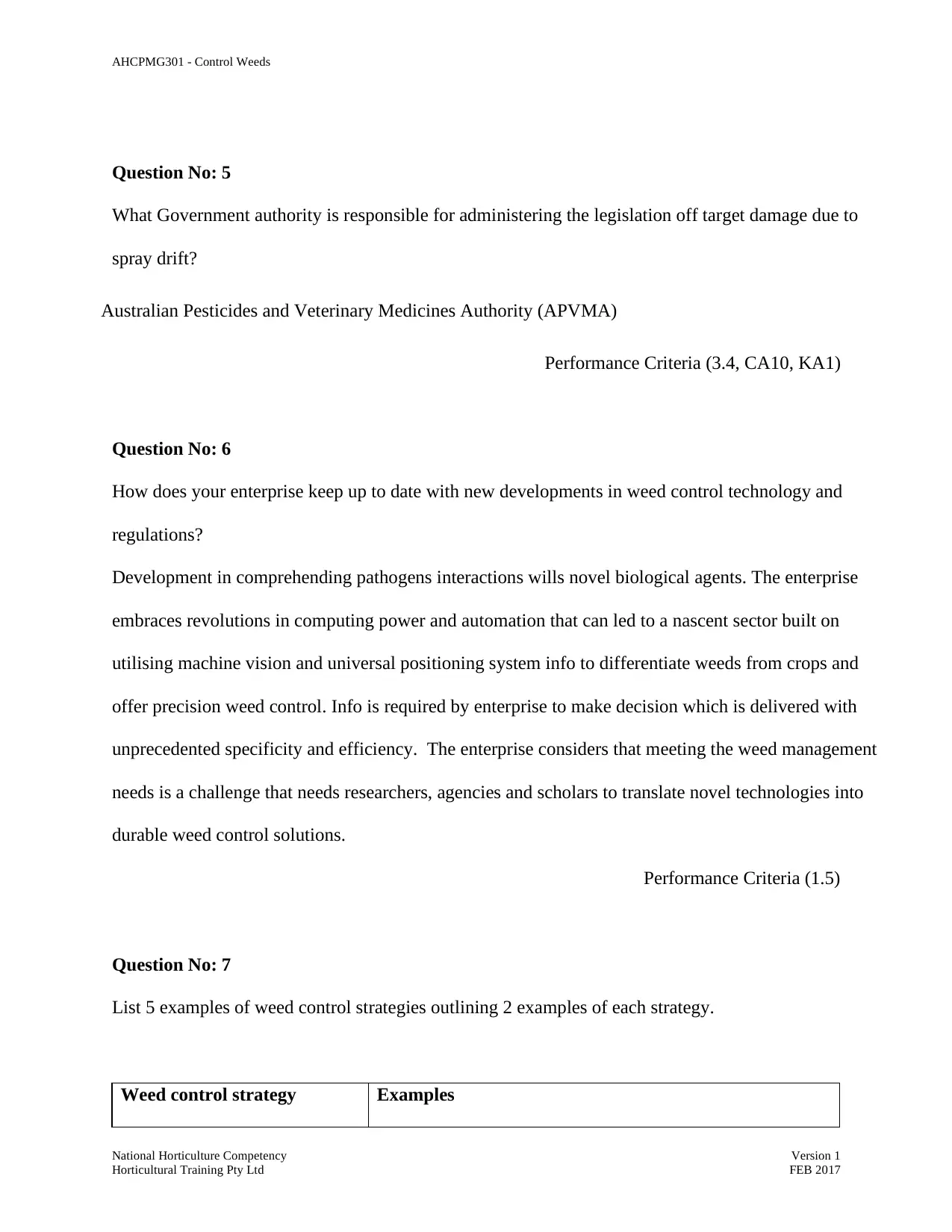
AHCPMG301 - Control Weeds
National Horticulture Competency
Horticultural Training Pty Ltd
Version 1
FEB 2017
Question No: 5
What Government authority is responsible for administering the legislation off target damage due to
spray drift?
Australian Pesticides and Veterinary Medicines Authority (APVMA)
Performance Criteria (3.4, CA10, KA1)
Question No: 6
How does your enterprise keep up to date with new developments in weed control technology and
regulations?
Development in comprehending pathogens interactions wills novel biological agents. The enterprise
embraces revolutions in computing power and automation that can led to a nascent sector built on
utilising machine vision and universal positioning system info to differentiate weeds from crops and
offer precision weed control. Info is required by enterprise to make decision which is delivered with
unprecedented specificity and efficiency. The enterprise considers that meeting the weed management
needs is a challenge that needs researchers, agencies and scholars to translate novel technologies into
durable weed control solutions.
Performance Criteria (1.5)
Question No: 7
List 5 examples of weed control strategies outlining 2 examples of each strategy.
Weed control strategy Examples
National Horticulture Competency
Horticultural Training Pty Ltd
Version 1
FEB 2017
Question No: 5
What Government authority is responsible for administering the legislation off target damage due to
spray drift?
Australian Pesticides and Veterinary Medicines Authority (APVMA)
Performance Criteria (3.4, CA10, KA1)
Question No: 6
How does your enterprise keep up to date with new developments in weed control technology and
regulations?
Development in comprehending pathogens interactions wills novel biological agents. The enterprise
embraces revolutions in computing power and automation that can led to a nascent sector built on
utilising machine vision and universal positioning system info to differentiate weeds from crops and
offer precision weed control. Info is required by enterprise to make decision which is delivered with
unprecedented specificity and efficiency. The enterprise considers that meeting the weed management
needs is a challenge that needs researchers, agencies and scholars to translate novel technologies into
durable weed control solutions.
Performance Criteria (1.5)
Question No: 7
List 5 examples of weed control strategies outlining 2 examples of each strategy.
Weed control strategy Examples
Paraphrase This Document
Need a fresh take? Get an instant paraphrase of this document with our AI Paraphraser
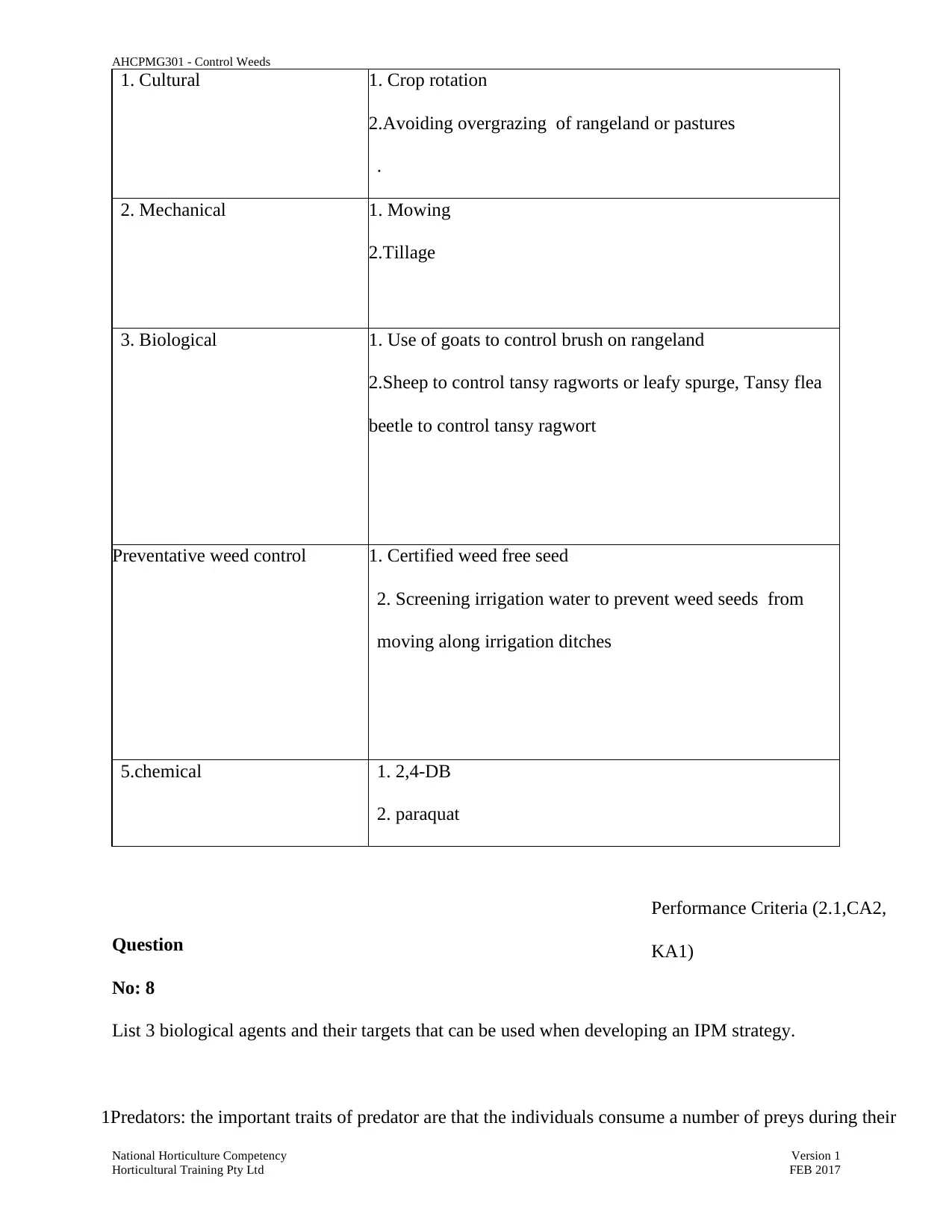
AHCPMG301 - Control Weeds
National Horticulture Competency
Horticultural Training Pty Ltd
Version 1
FEB 2017
1. Cultural 1. Crop rotation
2.Avoiding overgrazing of rangeland or pastures
.
2. Mechanical 1. Mowing
2.Tillage
3. Biological 1. Use of goats to control brush on rangeland
2.Sheep to control tansy ragworts or leafy spurge, Tansy flea
beetle to control tansy ragwort
Preventative weed control 1. Certified weed free seed
2. Screening irrigation water to prevent weed seeds from
moving along irrigation ditches
5.chemical 1. 2,4-DB
2. paraquat
Question
No: 8
Performance Criteria (2.1,CA2,
KA1)
List 3 biological agents and their targets that can be used when developing an IPM strategy.
1Predators: the important traits of predator are that the individuals consume a number of preys during their
National Horticulture Competency
Horticultural Training Pty Ltd
Version 1
FEB 2017
1. Cultural 1. Crop rotation
2.Avoiding overgrazing of rangeland or pastures
.
2. Mechanical 1. Mowing
2.Tillage
3. Biological 1. Use of goats to control brush on rangeland
2.Sheep to control tansy ragworts or leafy spurge, Tansy flea
beetle to control tansy ragwort
Preventative weed control 1. Certified weed free seed
2. Screening irrigation water to prevent weed seeds from
moving along irrigation ditches
5.chemical 1. 2,4-DB
2. paraquat
Question
No: 8
Performance Criteria (2.1,CA2,
KA1)
List 3 biological agents and their targets that can be used when developing an IPM strategy.
1Predators: the important traits of predator are that the individuals consume a number of preys during their
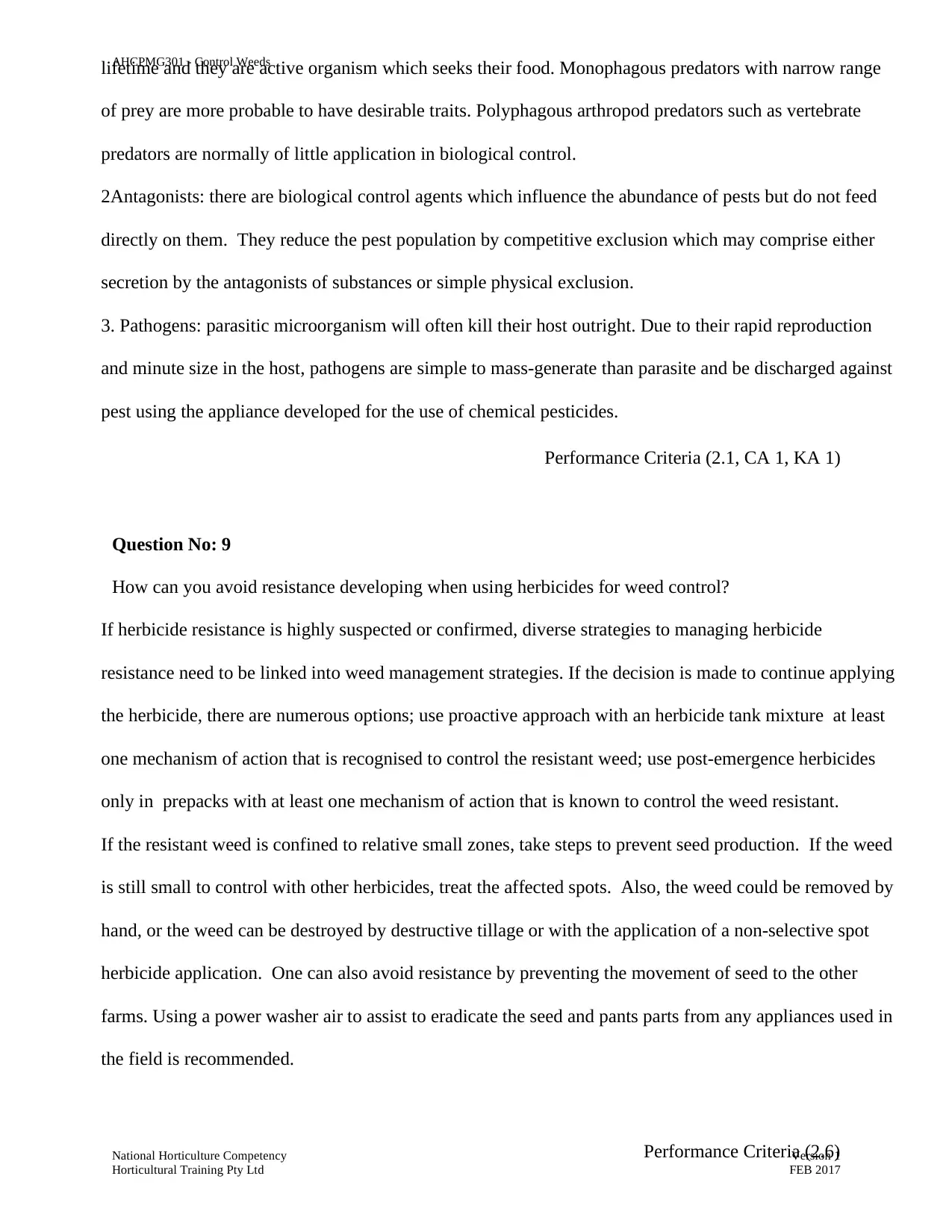
AHCPMG301 - Control Weeds
National Horticulture Competency
Horticultural Training Pty Ltd
Version 1
FEB 2017
lifetime and they are active organism which seeks their food. Monophagous predators with narrow range
of prey are more probable to have desirable traits. Polyphagous arthropod predators such as vertebrate
predators are normally of little application in biological control.
2Antagonists: there are biological control agents which influence the abundance of pests but do not feed
directly on them. They reduce the pest population by competitive exclusion which may comprise either
secretion by the antagonists of substances or simple physical exclusion.
3. Pathogens: parasitic microorganism will often kill their host outright. Due to their rapid reproduction
and minute size in the host, pathogens are simple to mass-generate than parasite and be discharged against
pest using the appliance developed for the use of chemical pesticides.
Performance Criteria (2.1, CA 1, KA 1)
Question No: 9
How can you avoid resistance developing when using herbicides for weed control?
If herbicide resistance is highly suspected or confirmed, diverse strategies to managing herbicide
resistance need to be linked into weed management strategies. If the decision is made to continue applying
the herbicide, there are numerous options; use proactive approach with an herbicide tank mixture at least
one mechanism of action that is recognised to control the resistant weed; use post-emergence herbicides
only in prepacks with at least one mechanism of action that is known to control the weed resistant.
If the resistant weed is confined to relative small zones, take steps to prevent seed production. If the weed
is still small to control with other herbicides, treat the affected spots. Also, the weed could be removed by
hand, or the weed can be destroyed by destructive tillage or with the application of a non-selective spot
herbicide application. One can also avoid resistance by preventing the movement of seed to the other
farms. Using a power washer air to assist to eradicate the seed and pants parts from any appliances used in
the field is recommended.
Performance Criteria (2.6)
National Horticulture Competency
Horticultural Training Pty Ltd
Version 1
FEB 2017
lifetime and they are active organism which seeks their food. Monophagous predators with narrow range
of prey are more probable to have desirable traits. Polyphagous arthropod predators such as vertebrate
predators are normally of little application in biological control.
2Antagonists: there are biological control agents which influence the abundance of pests but do not feed
directly on them. They reduce the pest population by competitive exclusion which may comprise either
secretion by the antagonists of substances or simple physical exclusion.
3. Pathogens: parasitic microorganism will often kill their host outright. Due to their rapid reproduction
and minute size in the host, pathogens are simple to mass-generate than parasite and be discharged against
pest using the appliance developed for the use of chemical pesticides.
Performance Criteria (2.1, CA 1, KA 1)
Question No: 9
How can you avoid resistance developing when using herbicides for weed control?
If herbicide resistance is highly suspected or confirmed, diverse strategies to managing herbicide
resistance need to be linked into weed management strategies. If the decision is made to continue applying
the herbicide, there are numerous options; use proactive approach with an herbicide tank mixture at least
one mechanism of action that is recognised to control the resistant weed; use post-emergence herbicides
only in prepacks with at least one mechanism of action that is known to control the weed resistant.
If the resistant weed is confined to relative small zones, take steps to prevent seed production. If the weed
is still small to control with other herbicides, treat the affected spots. Also, the weed could be removed by
hand, or the weed can be destroyed by destructive tillage or with the application of a non-selective spot
herbicide application. One can also avoid resistance by preventing the movement of seed to the other
farms. Using a power washer air to assist to eradicate the seed and pants parts from any appliances used in
the field is recommended.
Performance Criteria (2.6)
⊘ This is a preview!⊘
Do you want full access?
Subscribe today to unlock all pages.

Trusted by 1+ million students worldwide
1 out of 34
Related Documents
Your All-in-One AI-Powered Toolkit for Academic Success.
+13062052269
info@desklib.com
Available 24*7 on WhatsApp / Email
![[object Object]](/_next/static/media/star-bottom.7253800d.svg)
Unlock your academic potential
Copyright © 2020–2025 A2Z Services. All Rights Reserved. Developed and managed by ZUCOL.





